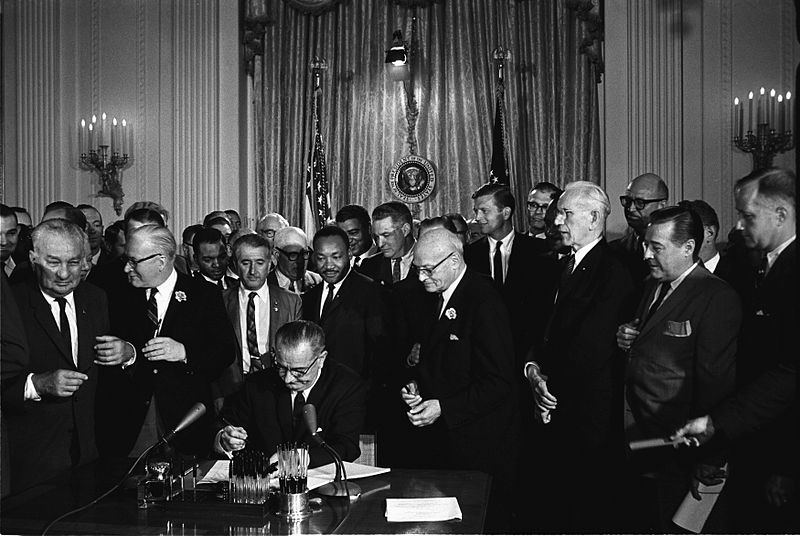4.3: Anti-Discrimination Legislation
- Page ID
- 47011
- Summarize the discrimination protections provided by Title VII of the Civil Rights Act of 1964
- Summarize the discrimination protections provided by the Civil Rights Act of 1991
- Identify additional laws & executive orders regarding discrimination
The Civil Rights Act of 1964

History.com notes that “The Civil Rights Act of 1964, which ended segregation in public places and banned employment discrimination on the basis of race, color, religion, sex or national origin, is considered one of the crowning legislative achievements of the civil rights movement.” Indeed, civil rights leader Martin Luther King, Jr. referred to the Act as a “second emancipation.” The Act was originally proposed by President John F. Kennedy, who stated, “the United States ‘will not be fully free until all of its citizens are free.’”[1] Despite strong opposition from southern Congressional members, including a record 75-day filibuster and a 14 hour speech by former Ku Klux Klan member and West Virginia Senator Robert Byrd, the Act passed and was signed into law by President Kennedy’s successor, Lyndon B. Johnson.
Fundamentals of Human Resource Management authors DeCenzo, et.al. also state that “no single piece of legislation has had a greater effect on reducing employment discrimination than the Civil Rights Act of 1964.” For Human Resource Management purposes, the section or “title” of the Act that’s particularly relevant is Title VII, which, as amended, “protects individuals against employment discrimination on the basis of race and color as well as national origin, sex, or religion.”[2] Title VII makes it unlawful to discriminate against any employee or applicant for employment because of race or color in regard to hiring, termination, promotion, compensation, job training, or any other term, condition, or privilege of employment. Title VII prohibits not only intentional discrimination but also neutral policies that disproportionately exclude minorities and are not job related. Title VII is applicable to private sector employers with fifteen or more employees, federal government employers, employment agencies, and labor organizations.
Title VII also prohibits employment decisions based on stereotypes and assumptions about abilities, traits, or the performance of individuals of certain racial groups. The law also makes it illegal to retaliate against a person because the person complained about discrimination, filed a charge of discrimination, or participated in an employment discrimination investigation or lawsuit. Finally, the law requires employers to make reasonable accommodations for applicants’ and employees’ sincerely held religious practices, unless doing so would impose an undue hardship on the operation of the employer’s business.
Title VII Exceptions
An employer is permitted to take employment actions that would otherwise be held as discriminatory if the decision is based on a bona fide occupational qualification (BFOQ). Workforce states that “Title VII of the Civil Rights Act of 1964 provides that employment decisions may be made on the basis of sex, religion, or national origin (but not race or color) if the sex, religion, or national origin is a BFOQ reasonably necessary to the normal operation of the business. The Age Discrimination in Employment Act of 1967 contains a similar provision for the BFOQ exception in regard to age.”[3]
To be applicable, a BFOQ exception must meet two conditions: (1) A particular religion, sex, national origin or age must be an actual qualification for performing the job; and (2) the requirement must be necessary to the normal operation of the employer’s business. The same exception is allowed for job notices and advertisements, where the position at issue requires a worker of a particular religion, sex, national origin or age. For example,
Civil.laws.com notes that “it would not be a violation of Title VII for a Jewish center to refuse employment to a Catholic individual in a shul or school funded by the congregation if the employment required a statement of adherence to and promulgation of Judaism or the Jewish faith.[4]
For additional perspective, refer to Cornell Law School’s discussion of BFOQ.
Civil Rights Act of 1991
The Civil Rights Act of 1991 was passed to address a series of decisions by the Supreme Court that undermined discrimination protections.[5] In effect, the law nullified these decisions, re-establishing an employers burden of proof and the disparate impact theory of discrimination. The Act also amended “Title VII and the ADA to permit jury trials and compensatory and punitive damage awards in intentional discrimination cases.”[6] Specifically, “the Act provided that where the plaintiff shows that discrimination was a motivating factor for an employment decision, the employer is liable for injunctive relief, attorney’s fees, and costs (but not individual monetary or affirmative relief) even though it proves it would have made the same decision in the absence of a discriminatory motive.”[7]
The Act also extended employment discrimination protection to employees of Congress and Title VII and ADA coverage to include American and American-controlled employers operating abroad.
The Equal Pay Act (APA) of 1963

The Equal Pay Act (APA) of 1963 makes it illegal to pay different wages to men and women if they perform equal work in the same workplace. The law also makes it illegal to retaliate against a person because the person complained about discrimination, filed a charge of discrimination, or participated in an employment discrimination investigation or lawsuit. The EPA is discussed further here.
The Age Discrimination in Employment Act (ADEA) of 1976
ADEA protects applicants and employees 40 years or older from discrimination because of age and for retaliation for a discrimination complaint or related action. ADEA applies to private employers with 20 or more employees, state and local governments, employment agencies, labor organizations and the federal government. As mentioned above, it is generally unlawful to to state an age-related preference in job advertisements except when age is demonstrated to be a BFOQ. In a Recruitment & Selection training manual, SHRM recommends cross-referencing state’s discrimination laws, noting that “some states require compliance with age discrimination law for employers of two or more workers, and some states have lowered the age discrimination threshold far below 40 years old.”
The Pregnancy Discrimination Act of 1978
The Pregnancy Discrimination Act of 1978 is an amendment to Title VII of the Civil Rights Act. The Act makes it illegal to discriminate against a woman because of pregnancy, childbirth, or a medical condition related to pregnancy or childbirth. SHRM notes that “the basic principle is that a woman affected by pregnancy or other related medical condition must be treated the same as any other applicant in the recruitment and selection process.” The law also makes it illegal to retaliate against a person because the person complained about discrimination, filed a charge of discrimination, or participated in an employment discrimination investigation or lawsuit.
Title I of the Americans with Disabilities Act (ADA) of 1990
Title I makes it illegal to discriminate against a qualified person with a disability in the private sector and in state and local governments. The law also makes it illegal to retaliate against a person because the person complained about discrimination, filed a charge of discrimination, or participated in an employment discrimination investigation or lawsuit. The law also requires that employers reasonably accommodate the known physical or mental limitations of an otherwise qualified individual with a disability who is an applicant or employee, unless doing so would impose an undue hardship on the operation of the employer’s business. SHRM expands on the EEOC description, stating that “employers are prohibited from using an employment test to disqualify a disabled candidate unless that test is valid for the skills necessary in the job to which they are applying and unless the same test is given to all applicants, not just to those with disabilities.” Sections 501 and 505 of the Rehabilitation Act of 1973 extend ADA Title I protections to federal government applicants and employees.
The Genetic Information Nondiscrimination Act (GINA) of 2008
GINA makes it illegal to discriminate against employees or applicants because of genetic information. Genetic information includes information about an individual’s genetic tests and the genetic tests of an individual’s family members, as well as information about any disease, disorder or condition of an individual’s family members (i.e. an individual’s family medical history). The law also makes it illegal to retaliate against a person because the person complained about discrimination, filed a charge of discrimination, or participated in an employment discrimination investigation or lawsuit.
SHRM’s caution regarding differences in state and local versus federal laws applies across the board, and state/local laws are generally more stringent. HR personnel are advised to contact the relevant state department of labor to confirm the extent of specific employment laws and to develop a process to remain up to date on changes.
Executive Orders
Executive orders generally extend discrimination protections to federal workers, including those working under federal contracts.
- Executive Order (E.O.) 11246. Issued by President Lyndon B. Johnson, prohibits federal contractors from discriminating “against any employee or applicant for employment because of race, color, religion, sex, or national origin.” Amended by President Obama (E.O. 13672)[8] to extend protection to include sexual orientation or gender identity.[9]
- E.O. 11478. Issued by President Nixon, bars discrimination against federal employees on the basis of race, color, religion, sex, national origin, disability, and age. Amended by President Clinton (E.O 13087) to include sexual orientation as a protected category. Amended by President Obama (E.O. 13672)[10] to extend protection to include gender identity as a protected category.
- History.com Editors. "Civil Rights Act of 1964." History.com. January 4, 2010. Accessed September 14, 2019. ↵
- "Title VII of the Civil Rights Act of 1964." U.S. Equal Employment Opportunity Commission. Accessed September 14, 2019. ↵
- Staff Report. "The BFOQ Exception to Discrimination Laws." WorkForce. December 24, 1999. Accessed September 14, 2019. ↵
- "Title VII of the Civil Rights Act." Laws. Accessed September 14, 2019. ↵
- "The Civil Rights Act of 1991." EEOC. Accessed September 14, 2019. ↵
- "Laws Enforced by EEOC." U.S. Equal Employment Opportunity Commission. Accessed September 14, 2019. ↵
- "The Civil Rights Act of 1991." EEOC. Accessed September 14, 2019. ↵
- "Executive Order 13672." U.S. Equal Employment Opportunity Commission. Accessed September 14, 2019. ↵
- Winston & Strawn LLP. "President Obama Signs Amendments to Executive Orders Supporting LGBT Workplace Equality." Lexology. July 22, 2014. Accessed September 14, 2019. ↵
- "Executive Order 13672." U.S. Equal Employment Opportunity Commission. ↵
Contributors and Attributions
- Untitled. Authored by: Wesley Tingey. Provided by: Unsplash. Located at: https://unsplash.com/photos/9z9fxr_7Z-k. License: CC0: No Rights Reserved. License Terms: Unsplash License
- Lyndon Johnson signing Civil Rights Act. Authored by: Cecil Stoughton. Provided by: White House Press Office. Located at: https://commons.wikimedia.org/wiki/File:Lyndon_Johnson_signing_Civil_Rights_Act,_July_2,_1964.jpg. License: Public Domain: No Known Copyright


